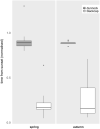Are movements of daytime and nighttime passerine migrants as different as day and night?
- PMID: 33144946
- PMCID: PMC7593151
- DOI: 10.1002/ece3.6704
Are movements of daytime and nighttime passerine migrants as different as day and night?
Abstract
Even after decades of research, the migration of songbirds still holds numerous secrets. Distinct stopover and routing behavior of diurnally and nocturnally migrating songbirds has been stated in the 1960s, but empirical confirmation is yet lacking widely. We studied the behavior of individual diurnally migrating dunnocks and nocturnally migrating blackcaps by means of large-scale automated radio-telemetry. Birds were radio-tagged during their stopover at the German North Sea coast. Our data indicate longer initial stopover duration in the diurnally migrating dunnocks, opposing the hypothesis of nocturnal migrants needing more time to recover due to their longer migratory flights. Nonetheless, dunnocks stopped over more often along their tracks as when compared to the nocturnally migrating blackcaps. Behavior en route did not differ as clearly between species challenging the general view of contrasting routings of diurnal and nocturnal migrants with regard to landscape and open water. Our results imply additional factors of relevance other than differences in species or daily migration timing per se. We discuss and highlight the need of detailed and individual based data to better understand stopover and routing behavior of songbirds in the environmental context.
Keywords: North Sea; blackcap; diurnal versus nocturnal migration; dunnock; radio‐telemetry; stopover.
© 2020 The Authors. Ecology and Evolution published by John Wiley & Sons Ltd.
Conflict of interest statement
None declared.
Figures





Similar articles
-
The urge to breed early: Similar responses to environmental conditions in short- and long-distance migrants during spring migration.Ecol Evol. 2023 Jul 4;13(7):e10223. doi: 10.1002/ece3.10223. eCollection 2023 Jul. Ecol Evol. 2023. PMID: 37408622 Free PMC article.
-
Stopover departure decisions in songbirds: do long-distance migrants depart earlier and more independently of weather conditions than medium-distance migrants?Mov Ecol. 2020 Feb 7;8:6. doi: 10.1186/s40462-020-0193-1. eCollection 2020. Mov Ecol. 2020. PMID: 32047634 Free PMC article.
-
To cross or not to cross - thrushes at the German North Sea coast adapt flight and routing to wind conditions in autumn.Mov Ecol. 2019 Oct 31;7:32. doi: 10.1186/s40462-019-0173-5. eCollection 2019. Mov Ecol. 2019. PMID: 31695918 Free PMC article.
-
Towards a conceptual framework for explaining variation in nocturnal departure time of songbird migrants.Mov Ecol. 2016 Oct 17;4:24. doi: 10.1186/s40462-016-0089-2. eCollection 2016. Mov Ecol. 2016. PMID: 27833750 Free PMC article. Review.
-
Understanding the ecological and evolutionary function of stopover in migrating birds.Biol Rev Camb Philos Soc. 2022 Aug;97(4):1231-1252. doi: 10.1111/brv.12839. Epub 2022 Feb 8. Biol Rev Camb Philos Soc. 2022. PMID: 35137518 Review.
Cited by
-
Departure, routing and landing decisions of long-distance migratory songbirds in relation to weather.R Soc Open Sci. 2023 Feb 8;10(2):221420. doi: 10.1098/rsos.221420. eCollection 2023 Feb. R Soc Open Sci. 2023. PMID: 36778957 Free PMC article.
-
Night flight facilitates late breeding catch-up in a long-distance migratory seabird.Sci Rep. 2024 Dec 30;14(1):31792. doi: 10.1038/s41598-024-82328-4. Sci Rep. 2024. PMID: 39738235 Free PMC article.
-
The urge to breed early: Similar responses to environmental conditions in short- and long-distance migrants during spring migration.Ecol Evol. 2023 Jul 4;13(7):e10223. doi: 10.1002/ece3.10223. eCollection 2023 Jul. Ecol Evol. 2023. PMID: 37408622 Free PMC article.
References
-
- Alerstam, T. (1976). Bird migration in relation to wind and topography. Lund: Department of Animal Ecology, University of Lund.
-
- Alerstam, T. (1990). Bird Migration. Cambridge, UK: Cambridge University Press.
-
- Alerstam, T. (2003). Bird migration speed In Berthold P., Gwinner E., & Sonnenschein E. (Eds), Avian migration (pp. 253–267). Berlin, Heidelberg: Springer.
-
- Alerstam, T. (2011). Optimal bird migration revisited. Journal of Ornithology, 152(S1), 5–23. 10.1007/s10336-011-0694-1. - DOI
LinkOut - more resources
Full Text Sources
Research Materials

